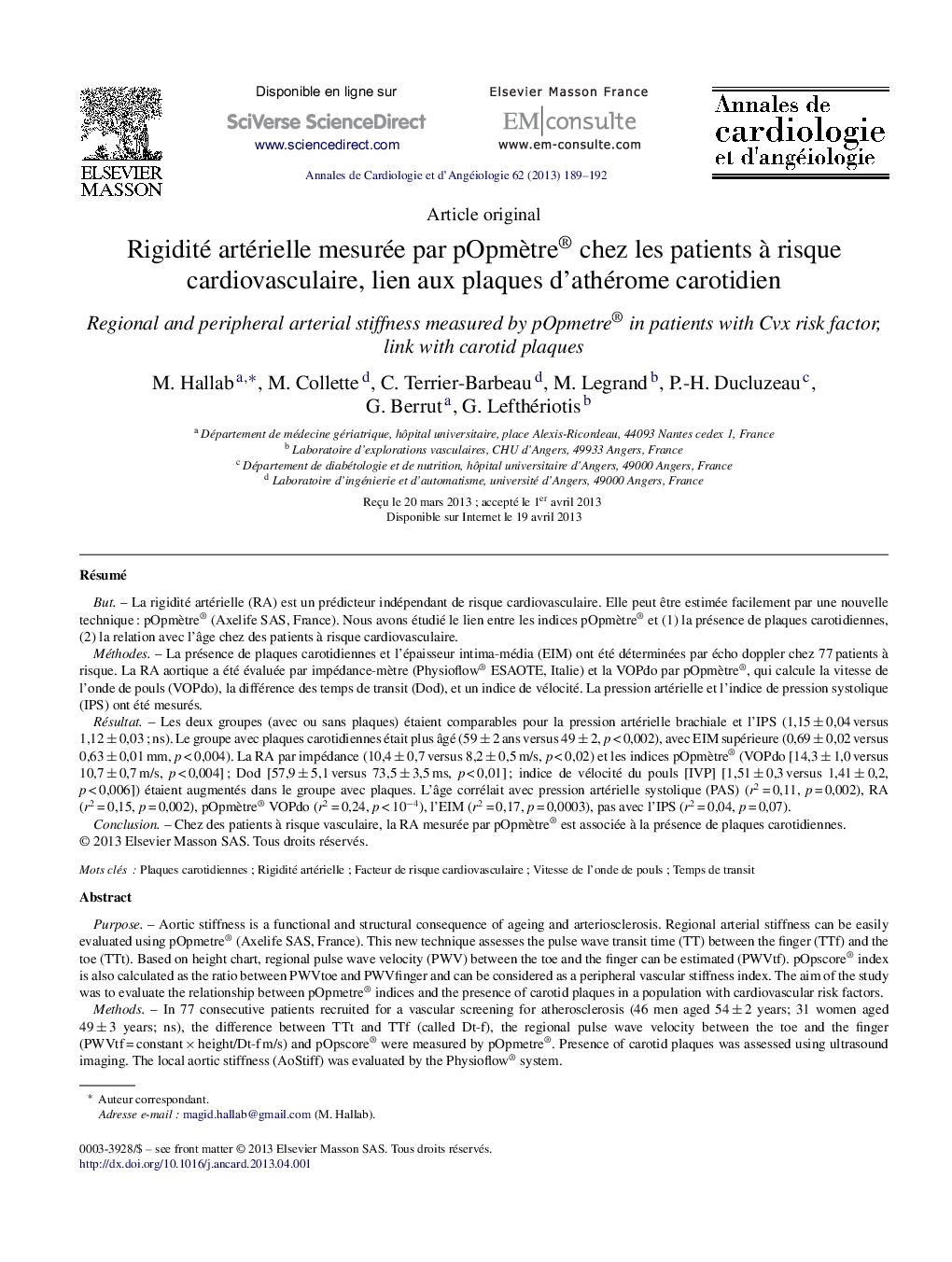| کد مقاله | کد نشریه | سال انتشار | مقاله انگلیسی | نسخه تمام متن |
|---|---|---|---|---|
| 2869030 | 1171218 | 2013 | 4 صفحه PDF | دانلود رایگان |

RésuméButLa rigidité artérielle (RA) est un prédicteur indépendant de risque cardiovasculaire. Elle peut être estimée facilement par une nouvelle technique : pOpmètre® (Axelife SAS, France). Nous avons étudié le lien entre les indices pOpmètre® et (1) la présence de plaques carotidiennes, (2) la relation avec l’âge chez des patients à risque cardiovasculaire.MéthodesLa présence de plaques carotidiennes et l’épaisseur intima-média (EIM) ont été déterminées par écho doppler chez 77 patients à risque. La RA aortique a été évaluée par impédance-mètre (Physioflow® ESAOTE, Italie) et la VOPdo par pOpmètre®, qui calcule la vitesse de l’onde de pouls (VOPdo), la différence des temps de transit (Dod), et un indice de vélocité. La pression artérielle et l’indice de pression systolique (IPS) ont été mesurés.RésultatLes deux groupes (avec ou sans plaques) étaient comparables pour la pression artérielle brachiale et l’IPS (1,15 ± 0,04 versus 1,12 ± 0,03 ; ns). Le groupe avec plaques carotidiennes était plus âgé (59 ± 2 ans versus 49 ± 2, p < 0,002), avec EIM supérieure (0,69 ± 0,02 versus 0,63 ± 0,01 mm, p < 0,004). La RA par impédance (10,4 ± 0,7 versus 8,2 ± 0,5 m/s, p < 0,02) et les indices pOpmètre® (VOPdo [14,3 ± 1,0 versus 10,7 ± 0,7 m/s, p < 0,004] ; Dod [57,9 ± 5,1 versus 73,5 ± 3,5 ms, p < 0,01] ; indice de vélocité du pouls [IVP] [1,51 ± 0,3 versus 1,41 ± 0,2, p < 0,006]) étaient augmentés dans le groupe avec plaques. L’âge corrélait avec pression artérielle systolique (PAS) (r2 = 0,11, p = 0,002), RA (r2 = 0,15, p = 0,002), pOpmètre® VOPdo (r2 = 0,24, p < 10−4), l’EIM (r2 = 0,17, p = 0,0003), pas avec l’IPS (r2 = 0,04, p = 0,07).ConclusionChez des patients à risque vasculaire, la RA mesurée par pOpmètre® est associée à la présence de plaques carotidiennes.
PurposeAortic stiffness is a functional and structural consequence of ageing and arteriosclerosis. Regional arterial stiffness can be easily evaluated using pOpmetre® (Axelife SAS, France). This new technique assesses the pulse wave transit time (TT) between the finger (TTf) and the toe (TTt). Based on height chart, regional pulse wave velocity (PWV) between the toe and the finger can be estimated (PWVtf). pOpscore® index is also calculated as the ratio between PWVtoe and PWVfinger and can be considered as a peripheral vascular stiffness index. The aim of the study was to evaluate the relationship between pOpmetre® indices and the presence of carotid plaques in a population with cardiovascular risk factors.MethodsIn 77 consecutive patients recruited for a vascular screening for atherosclerosis (46 men aged 54 ± 2 years; 31 women aged 49 ± 3 years; ns), the difference between TTt and TTf (called Dt-f), the regional pulse wave velocity between the toe and the finger (PWVtf = constant × height/Dt-f m/s) and pOpscore® were measured by pOpmetre®. Presence of carotid plaques was assessed using ultrasound imaging. The local aortic stiffness (AoStiff) was evaluated by the Physioflow® system.ResultsNo difference was found between patients with or without carotid plaques (n = 25 versus 52) for Ankle-Brachial Pressure Index (ABPI: 1.15 ± 0.04 versus 1.12 ± 0.03), nor for diastolic or systolic blood pressure (87 ± 3 versus 82 ± 2; 137 ± 3 versus 132 ± 2 mmHg). The first group was older than the second (59 ± 2 versus 49 ± 2 years, P < 0.002) with a larger intimae media thickness (0.69 ± 0.02 versus 0.63 ± 0.01 mm, P < 0.004), a higher AoStiff (10.4 ± 0.7 versus 8.2 ± 0.5 m/s, P < 0.02), and PWVtf (14.3 ± 1.0 versus 10.7 ± 0.7 m/s, P < 0.004) and a shorter Dt-f (57.9 ± 5.1 versus 73.5 ± 3.5 ms, P < 0.01). PWVtf (r2 = 0.49, P < 0.0001) and Dt-f (r2 = 0.54, P < 0.0001) correlated with age. A significant difference in pOpscore® index was observed between both groups (1.51 ± 0.3 versus 1.41 ± 0.2, P < 0.006).ConclusionOur results show a significant arterial stiffness indices measured by pOpmetre® in patients with and without carotid plaques.
Journal: Annales de Cardiologie et d'Angéiologie - Volume 62, Issue 3, June 2013, Pages 189–192